|

from
Thuntherbolts Website
Jan 20, 2005

Credit: Image: ESA/NASA/JPL/University
of Arizona
Titanís atmosphere has scientists puzzled. Unlike all other large
moons, it has an atmosphere. And that atmosphere is the densest of
any terrestrial planet after Venus. Itís also far more extensive
than Venusís, stretching out to about 880 km. The haze layers seen
in the image above reach a height of 400 km above Titan.
The plethora of puzzles evokes contrary guesses at answers from
scientists. Toby Owens, principal scientist at the Jet Propulsion
Laboratory, surmised:
"What weíve got is a very primitive atmosphere
that has been preserved for 4.6 billion years. Titan gives us the
chance for cosmic time travel . . . going back to the very earliest
days of Earth when it had a similar atmosphere."
The New Scientist, in its November 6 issue, supposed:
ďTitan appears
to have lost much of its original atmosphere. The moon has an
unusually high abundance of nitrogen-15, compared with the lighter
isotope nitrogen-14. That could be explained if most of the
atmosphere had evaporated into space, a process in which the nitrogen-14 would have escaped more easily than
nitrogen-15. What
could cause such a loss is unknown, but it would mean that Titan
once had an atmosphere 40 times as thick as Earthís - making it a
dwarf version of a gas planet."
An earlier conjecture expected to find oceans of methane thought
necessary to replace its continual loss from the upper atmosphere
over the presumed age of Titan Ė more than 4 billion years.
The
Electric Universe views the puzzles of
Titanís atmosphere as
evidence of its youth. There is no need for a methane ocean if the
moon is young. Because moons are born episodically in "electrical
parturition" events, they will not be all the same age nor have the
same composition. The striking disparity in nitrogen isotopes tells
us more about the way planetary atmospheres are formed than how they
evolve in isolation. Several processes in the plasma discharge model
of planet birth will have significant effects on their atmospheres.
The primary variation in composition comes from the source and depth
of the ejection from the parent planet. In addition, the plasma gun
effect (seen now ejecting material from Io into space) is known from
laboratory tests to be a copious source of neutrons. The
neutrons
may be captured and change isotopic ratios or generate radioactive
species and in that process transmute elements in the ejected
material.
Also, the strong electric field in an ejection event can accelerate
charged particles and transmute elements. For example, nitrogen-14
can capture an electron to become carbon-14. Carbon-14 decays by
very weak beta decay back to nitrogen-14, with a half-life of
approximately 5,730 years. If the age of Titanís atmosphere can be
measured in thousands of years instead of billions, then a
significant amount of nitrogen-14 may still be locked up on Titan as
carbon-14.
Another little-known process is the catalytic nuclear conversion of
nitrogen to carbon monoxide. The intrinsic mass/energy difference
between the nitrogen molecule and the carbon monoxide molecule is
quite small. Nitrogen-14 molecules, in a hot plasma and in the
presence of a catalyst such as iron, have been demonstrated to
convert to carbon monoxide molecules. Both carbon monoxide and
carbon dioxide have been discovered in Titanís atmosphere.
Furthermore, several mechanisms in plasma discharges sort material
into regions of like isotopes, elements, or compounds. A moon that
forms from only part of the ejected material may have a composition
quite different from the remainder of the material.
A new moon ejected into a system of pre-existing moons will likely
disrupt that system. Close passages to other moons will result in
electrical interactions as the entire system adjusts to reach "least
interaction" orbits. These further interactions will exchange and
transmute material on all the moons involved, electrically scarring
their surfaces in the process.
A final puzzle was reported by Emily Lakdawalla of The Planetary
Society:
ďOne thing that may have helped the probe last a long time
was that it appeared to stay unexpectedly warm. At an elevation of
only 50 kilometers (about 30 miles) above the surface, her interior
was still at a balmy 25 C (77 F), despite the outside temperature
being a frigid -180 C (-290 F). [Project scientist Jean-Pierre]
Lebreton wasnít ready to say what this might mean. It could be
over-performance of the spacecraft, but it could also mean a wide
variety of unexpected things about the atmosphere.Ē
If Titan, like
Venus, is a young, recently ejected body, it may
still be cooling from its "natal heat."
|

